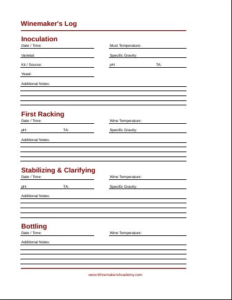The best way to learn from past successes and failures is by taking detailed notes in a wine making log. Previously I shared how to create a log using a notebook here.
Over time I found that I wanted a more structured document to keep track of all the important measurements. To that end I created a free wine making log that fits on a single sheet of paper that I’d like to share with you.
The Free Wine Making Log

This has been tailored for kit wine making but can also be used when making wine with frozen must or fresh grapes.
If you’d like a copy of the log it is a free download. Just click here or on the picture.
Print this sheet out before you start your next wine and keep it with you as you progress through the steps of the wine making process. There are places to record all the important data as well as taking some notes of your own.
Additional Notes Worth Taking
There are several places on the winemaker’s log for “additional notes” where you might want to include some more observations. Here are a few suggestions of things that can come in handy when looking back over your notes.
First, I recommend noting the ambient temperature where you store your wine. While the must temperature is very important when inoculating the yeast it’s also good to know what temperature the wine will settle down to.
When temperatures get too low everything slows down and your degassing time will increase many times over. If things get too warm you can ferment too quickly and you risk picking up cooked flavors.
Because the fermentation process gives off heat you’ll want to factor the ambient temperature into your plans. If your wine making area is at the upper limit of recommended temperatures the heat produced during fermentation may be enough to make your wine too warm.
Another worthwhile bit of information to record are visual observations. Take some notes on what the must looks, smells, or tastes like each time you perform a step of the wine making process. This way you’ll start to understand how a wine develops from start to finish.
Lastly, you’ll want to note anything that didn’t go quite as planned. Did some of the wine spill? Did you forget to stir everything up really well? Did degassing take 40 minutes instead of 2?
Fill out the winemaker’s log completely. Don’t worry about recording too much information. You never know what will be nice to know later on as you’re drinking your wine. As you get to know the winemaking process better the notes you take will start to have more meaning.
The best way to grow as a winemaker would be to review these winemaking logs after you’ve finished and bottled the wine. The next time you take a bottle off the rack to enjoy take a minute to review your log. You may find that over time you’re able to identify how specific steps in the process have affected your finished wine.
Feel free to share this wine making log with anyone you like. It was created to help us all make better wine.
Click here to download the Free Wine Making Log.

